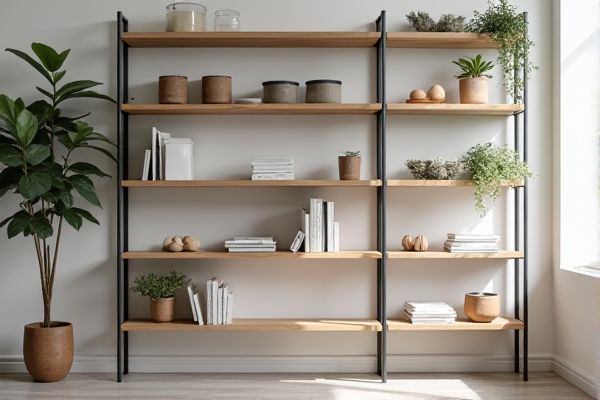
Single-layer shelves offer a fixed, sturdy storage solution ideal for organizing items of uniform height, while adjustable shelves provide flexibility to customize space according to varying storage needs and item sizes. Explore this article to discover which shelving option best fits Your storage requirements and lifestyle.
Table of Comparison
| Feature | Single-Layer Shelves | Adjustable Shelves |
|---|---|---|
| Design | Fixed height and position | Customizable height and layout |
| Flexibility | Limited, no repositioning | Highly flexible, easy to reposition |
| Installation | Simple, one-time setup | Moderate, requires fitting adjustable components |
| Cost | Generally lower cost | Typically higher price |
| Use Case | Best for storing items of uniform size | Ideal for varied item sizes and storage needs |
| Durability | Strong and stable due to fixed design | Good, but hinges or brackets may wear over time |
Introduction to Shelf Types
Single-layer shelves offer a fixed storage solution designed for stability and simplicity, ideal for organizing items of uniform size. Adjustable shelves provide versatile storage options, allowing you to customize shelf height to accommodate varying item dimensions and optimize space efficiency. Choosing between these shelf types depends on your specific storage needs and the flexibility required for your space.
What Are Single-Layer Shelves?
Single-layer shelves consist of one fixed horizontal surface designed to hold items without the option of height adjustment, offering sturdy support and simplicity in installation. These shelves are ideal for displaying or storing objects of consistent size, ensuring maximum stability and ease of access. Compared to adjustable shelves, single-layer shelves provide a straightforward, space-efficient storage solution with fewer moving parts and maintenance requirements.
Advantages of Single-Layer Shelves
Single-layer shelves offer a straightforward design that maximizes stability and load-bearing capacity, making them ideal for heavy or bulky items. Their fixed structure reduces the need for adjustments, ensuring consistent organization and easy access to stored products. You benefit from enhanced durability and a clutter-free appearance, which streamlines your storage space efficiently.
Limitations of Single-Layer Shelves
Single-layer shelves often have fixed spacing that limits storage versatility and restricts the size of items they can hold. This rigid structure can result in inefficient use of vertical space and difficulty accommodating taller or irregularly shaped objects. Adjustable shelves provide customizable height options, which improve organization and maximize available storage capacity.
Understanding Adjustable Shelves
Adjustable shelves offer versatile storage solutions by allowing customization of shelf heights to accommodate items of varying sizes, improving space efficiency in closets and cabinets. Unlike single-layer shelves with fixed positions, adjustable shelves maximize usability through movable brackets or tracks, supporting diverse organizational needs. This flexibility enhances accessibility and optimizes storage capacity, making adjustable shelves a preferred choice for dynamic storage environments.
Benefits of Adjustable Shelves
Adjustable shelves offer unparalleled flexibility by allowing you to customize shelf heights to fit items of various sizes, maximizing storage efficiency. These shelves adapt easily to changing storage needs, making them ideal for dynamic environments such as kitchens, offices, or retail spaces. By optimizing vertical space, adjustable shelves enhance organization and accessibility compared to fixed single-layer shelves.
Drawbacks of Adjustable Shelves
Adjustable shelves can be less stable and may sag over time, especially if the support pegs are not securely fitted or if heavy items are placed on them. The constant repositioning of these shelves can lead to wear and tear on the shelf brackets and side panels, weakening the overall structure. Your storage solution may suffer from reduced durability and increased maintenance compared to fixed, single-layer shelves.
Comparing Space Efficiency
Single-layer shelves maximize space efficiency by providing uniform storage height, ideal for items with consistent dimensions, while adjustable shelves offer flexibility by accommodating varied item sizes and optimizing vertical space. Your choice depends on whether you prioritize fixed organization or customizable space utilization. Adjustable shelves typically enhance overall storage capacity in irregular or changing storage scenarios.
Cost and Installation Differences
Single-layer shelves typically cost less due to simpler design and fewer materials, making them an economical choice for basic storage needs. Installation of single-layer shelves is straightforward, often requiring minimal tools and time, suitable for quick, permanent setups. Adjustable shelves involve higher initial costs because of versatile hardware and more complex brackets, while installation demands precise measurements and effort to ensure correct positioning and support.
Which Shelf Type Is Right for You?
Single-layer shelves offer a fixed height and sturdy support, ideal for heavy items or a minimalist look without frequent reorganization. Adjustable shelves provide versatile storage options, enabling customization to fit varying item sizes and changing needs over time. Choosing between these depends on your storage flexibility preferences and the types of items you'll be organizing.
 homyna.com
homyna.com